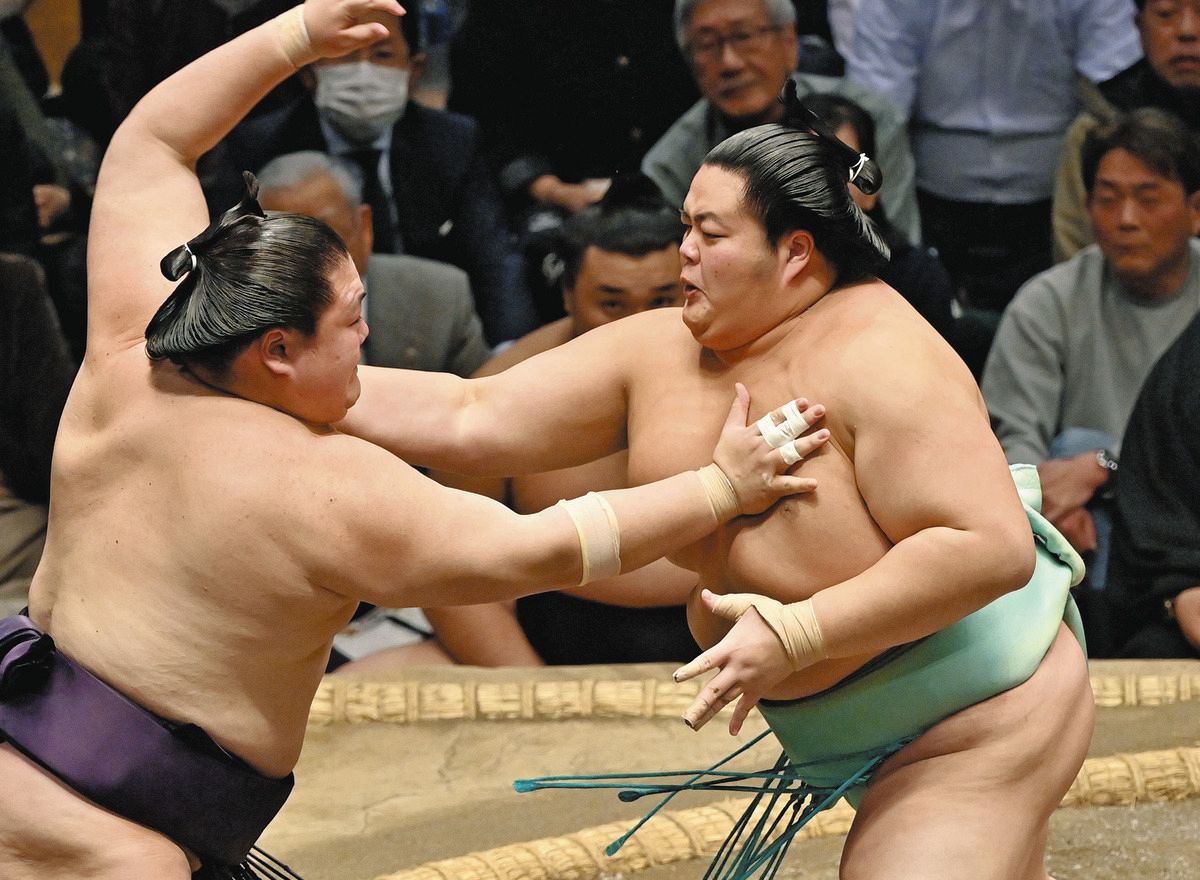相撲(すもう)は、日本の伝統的な格闘技で、力士(りきし)が土俵(どひょう)という円形の土の舞台で戦います。相撲は、力や技を競うだけでなく、精神的な面や儀式的な側面も重要です。以下に、相撲の基本的な情報を日本語と英語で説明します。
1. 相撲の基本
- 日本語: 相撲は、力士が互いに押し合い、相手を土俵から押し出すか、地面に倒すことを目的としたスポーツです。
- English: Sumo is a traditional Japanese sport where wrestlers (rikishi) compete to push each other out of a circular clay ring (dohyō) or to make their opponent touch the ground.
2. 力士と階級
- 日本語: 力士には、色々な階級があります。最高位は横綱(よこづな)で、その下に大関(おおぜき)、関脇(せきわけ)、小結(こむすび)などの階級があります。
- English: There are various ranks among sumo wrestlers. The highest rank is Yokozuna, followed by Ōzeki, Sekiwake, and Komusubi, among others.
3. 土俵と試合のルール
- 日本語: 土俵は直径約4.55メートルの円形で、木の枠で囲まれています。試合は、力士が互いに押し合って、相手を土俵から押し出すか、先に地面に触れさせた方が勝ちです。
- English: The dohyō is a circular ring with a diameter of about 4.55 meters, surrounded by a wooden frame. A match is won when a wrestler pushes their opponent out of the ring or forces them to touch the ground first.
4. 儀式と文化
- 日本語: 相撲は、単なるスポーツだけでなく、日本の伝統文化や宗教儀式とも深く結びついています。試合の前には、力士が土俵で塩をまいたり、四股(しこ)を踏んだりする儀式があります。
- English: Sumo is not just a sport; it is also deeply connected to Japanese traditional culture and religious rituals. Before matches, wrestlers perform rituals such as sprinkling salt on the dohyō and stomping their feet (shiko).
5. 大相撲の大会
- 日本語: 大相撲は、年に6回行われる本場所(ほんばしょ)という大会で開催され、各場所は約15日間続きます。東京の両国国技館(りょうごくこくぎかん)が主要な開催地です。
- English: Professional sumo tournaments, known as honbasho, are held six times a year, each lasting about 15 days. The main venue is the Ryōgoku Kokugikan in Tokyo.
6. 観戦の楽しみ
- 日本語: 相撲観戦は、観客にとっても魅力的です。生の試合を観ることで、迫力ある戦いと力士たちの技を体感できます。また、土俵上の力士の個性やストーリーも楽しめます。
- English: Watching sumo is exciting for spectators. Experiencing live matches allows you to feel the intense battles and the skills of the wrestlers. You can also enjoy the unique personalities and stories of the wrestlers on the dohyō.
相撲は日本の文化や伝統の重要な一部であり、多くの人に愛されています。興味がある方は、ぜひ生の相撲を観戦してみてください!
相撲に関する英単語と英語フレーズ
相撲に関する英単語とフレーズを以下にまとめました。これらは相撲を理解するのに役立ちます。
英単語
- Sumo – 相撲
- Wrestler – 力士
- Rikishi – 力士(相撲の専門用語)
- Dohyō – 土俵(相撲のリング)
- Yokozuna – 横綱(最高位の力士)
- Ōzeki – 大関(横綱の下の位)
- Sekiwake – 関脇(大関の下の位)
- Komusubi – 小結(関脇の下の位)
- Shiko – 四股(力士が踏む足踏み)
- Tachiai – 立ち合い(試合開始の瞬間)
- Shussan – 出身(力士の出身地)
- Kachi-koshi – 勝ち越し(勝ち数が負け数を上回ること)
- Make-koshi – 負け越し(負け数が勝ち数を上回ること)
- Chanko-nabe – ちゃんこ鍋(力士が食べる料理)
- Salt – 塩(試合前に土俵にまくもの)
英語フレーズ
- “What is sumo?”
(相撲とは何ですか?) - “How do you become a rikishi?”
(力士になるにはどうすればよいですか?) - “The yokozuna is the highest rank in sumo.”
(横綱は相撲の最高位です。) - “The dohyō is made of clay.”
(土俵は土でできています。) - “I enjoy watching sumo matches.”
(相撲の試合を見るのが好きです。) - “What is the difference between ōzeki and sekiwake?”
(大関と関脇の違いは何ですか?) - “A rikishi practices shiko to strengthen his legs.”
(力士は四股を踏んで足を鍛えます。) - “The match begins with a tachiai.”
(試合は立ち合いで始まります。) - “Chanko-nabe is a nutritious dish for wrestlers.”
(ちゃんこ鍋は力士にとって栄養価の高い料理です。) - “He achieved kachi-koshi this tournament.”
(彼は今場所で勝ち越しを達成しました。)
これらの単語やフレーズを使って、相撲についての会話を楽しんでみてください!
相撲の歴史を日本語と英語で学ぼう
相撲の歴史は非常に古く、伝統的な日本文化の一部として深く根付いています。以下に、相撲の歴史を日本語と英語で簡潔に説明します。
相撲の歴史
もちろんです!相撲の歴史を日本語と英語を併記して説明します。
相撲の歴史
起源 / Origins
- 相撲の起源は、紀元前から続く古代の儀式にさかのぼります。
The origins of sumo can be traced back to ancient rituals that date back to before Christ. - 日本書紀には、相撲が神事として行われていたことが記されています。
Historical texts like the “Nihon Shoki” (Chronicles of Japan) mention sumo as a religious ceremony. - 最初は祭りや神への奉納として行われていました。
Initially, it was held as part of festivals and offerings to the gods.
武士と相撲 / Warriors and Sumo
- 平安時代(794-1185年)には、相撲が貴族の娯楽として発展しました。
During the Heian period (794-1185), sumo evolved as an entertainment for the nobility. - 鎌倉時代(1185-1333年)には武士たちも相撲を楽しむようになりました。
By the Kamakura period (1185-1333), samurai began to participate in sumo matches.
近世の発展 / Development in the Early Modern Period
- 江戸時代(1603-1868年)には、相撲が庶民の娯楽として広まりました。
In the Edo period (1603-1868), sumo became popular among the common people. - 土俵が整備され、プロの力士が登場しました。
The dohyō (ring) was established, and professional wrestlers emerged. - この時期に、現在のようなルールや階級が確立されました。
It was during this time that the rules and ranking system we know today were developed.
大相撲の確立 / Establishment of Professional Sumo
- 明治時代(1868-1912年)以降、相撲は国民的なスポーツとして認識されました。
After the Meiji period (1868-1912), sumo became recognized as a national sport. - 相撲協会が設立され、テレビ放送が始まると、相撲の人気は一層高まりました。
The Japan Sumo Association was established, and the introduction of television broadcasting further increased the popularity of sumo.
現代の相撲 / Modern Sumo
- 現在でも相撲は日本の文化の重要な一部です。
Today, sumo remains an important part of Japanese culture. - 国内外で多くのファンに支持されています。
It is supported by many fans both domestically and internationally. - 力士たちは伝統的な作法や儀式を守りながら、日々の稽古に励んでいます。
Wrestlers adhere to traditional practices and rituals while dedicating themselves to daily training.
このように、相撲の歴史は日本の文化や伝統と密接に関連しており、興味深いです。ぜひ相撲についてもっと学んでみてください!







相撲のことを日本語と英語で学ぼう